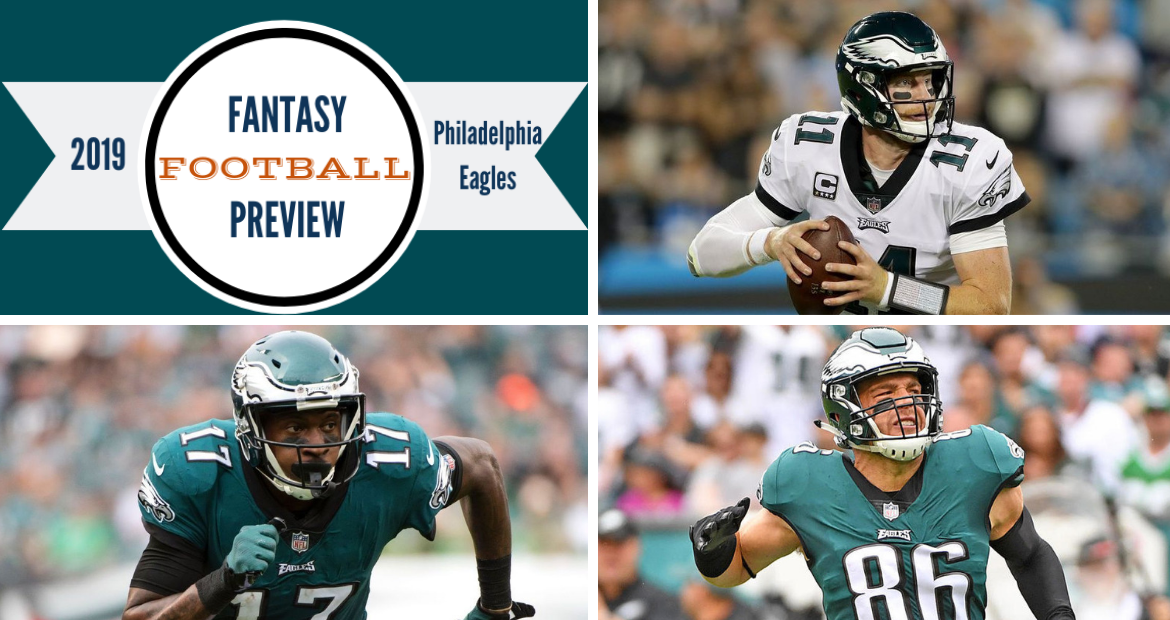
Fitz on Fantasy: 2019 Philadelphia Eagles Buying Guide
With the preseason nearing, TFG fantasy expert Pat Fitzmaurice is breaking down the prospects for all 32 teams. Click here for a running list of teams, and check back often as teams are added on an almost daily basis. On to the Philadelphia Eagles…
Carson Wentz’s arm is so powerful and dangerous that he’s only allowed to wear long-sleeve shirts in concealed-carry states. When fully healthy he’s been a nimble and willing runner. He’s protected by one of the best offensive lines in the league (which added the best pure pass protector in this year’s draft, Andre Dillard), and he has an abundance of talented pass catchers.
The 26-year-old Wentz may have been on his way to an MVP season in 2017 when he tore his ACL in a high-profile December road game against the Rams. Nick Foles took over and led the Eagles to their first championship since 1960, and then Wentz turned in a good-but-not-great performance last year before succumbing to a back injury.
The injuries should be the only hang-up here, although knee and back issues are no small thing. I’m not entirely “injury-agnostic” – a term used to describe the belief that past injury doesn’t make a player any more susceptible to future injury. But with Wentz’s golden combination of skill and situation, I’m willing to be the T.H. Huxley of injury agnosticism. If the room gives me Wentz at a discount, I’m taking him.
Zach Ertz was the busiest tight end in NFL history last year, with a league-record 116 catches on 156 targets. He finished with 1,163 yards and eight TDs to rank as the fantasy TE2 in PPR and half-PPR formats behind only Travis Kelce.
Ertz will no doubt be busy again in 2019 but the arrival of more pass catchers and the continued development of his young backup should give Ertz some help with the chores, maybe even allow him to take a quick nap on the couch. Ertz has an ADP of TE2, and I have no real quibble with that positional ranking (though I do like George Kittle a smidge more for 2019). But Ertz will go too early in a lot of drafts, greedily snatched up by owners too intoxicated by the 2018 numbers to see the inevitable statistical pullback coming.
During a tumultuous few days in June, fantasy analysts picked up their broadswords and donned chainmail to fight the Dallas Goedert Crusades, battling over whether the talented second-year tight end can have stand-alone fantasy value without an injury to Ertz. (I don’t want to call it a holy war, but, well … you can’t spell “Goedert” without “Go d.”)
Goedert hung up ridiculous receiving numbers at South Dakota State (92-1,293-11 as a junior, 72-1,111-7 as a senior) and posted respectable rookie numbers (33-334-4). Pro Football Focus graded the 6-4, 260-pound Goedert as the third-best run-blocking tight end in the league last year and awarded him a top-10 overall grade. Eagles coaches have been raving about Goedert’s efforts in the team’s offseason program.
The issue is that Goedert played 48% of the Eagles’ offseason snaps last season. Ertz played 92%. Even if head coach Doug Peterson and offensive coordinator Mike Groh use two-TE formations more often, Goedert will have a usage ceiling that will make him a dicey week-to-week start in redraft leagues. Goedert’s expert consensus ranking and average draft position are both TE21. Those are pretty good pot odds on a player with this much talent, but a lot of leagues are structured in a way that makes it illogical to draft a second tight end. Goedert might be worthwhile in a larger league, but don’t force the issue in smaller or medium-sized leagues.
As talented as Alshon Jeffery is, it’s hard to believe that he hasn’t had a 1,000-yard season since 2014. Injuries have had something to do with that, of course. Jeffery may have hands like catcher’s mitts, but his soft tissue is single-ply. He’s missed 20 games over seven NFL seasons and has dealt with repeated hamstring issues. Not that Jeffery’s toughness is to be questioned, mind you – the guy played a full season in 2017 with a torn rotator cuff.
After spending the early part of his career sharing targets with Brandon Marshall in Chicago, Jeffery now shares balls with one of the most prolific pass-catching tight ends in the league. Jeffery will be a prominent part of the attack, but with so many weapons on hand, Wentz can spread the love around, limiting Jeffery’s upside. With an ADP of WR29, Jeffery looks like a solid buy but perhaps not a screaming value.
Eagles fans are excited to have deep-ball artist DeSean Jackson back in Philadelphia. D-Jax never clicked with Jameis Winston in Tampa. As noted by Scott Barrett of Pro Football Focus (@ScottBarrettDFB), Jackson averaged 1.53 yards per route run while playing with Winston, far lower than his YPRR with nine of the other quarterbacks he’s played with, including Colt McCoy, Vince Young and Kevin Kolb.
Wentz hasn’t been an effective deep-ball thrower statistically, but he certainly has the arm to become one, and having Jackson around should help. But owning D-Jax is usually more fun in theory than in reality. His career average of 17.4 yards per catch leads all active receivers, and there will be weeks when he makes splash plays that accrue fantasy points in bunches, but there are also inevitable dry spells where he leaves donut holes in your lineup over a multi-week stretch. The feast-or-famine nature of Jackson game makes him a better investment in best-ball formats than in redraft leagues.
Nelson Agholor has elicited an interesting range of reactions from fantasy owners over his four-year career beginning with “He sucks,” followed by, “Hey, this guy is actually decent,” and now just a yawn. A former first-round draft pick, Agholor will probably be elsewhere next year, if not sooner. The Eagles’ late-season trade for Golden Tate last year looked like a vote of no confidence for Agholor, and it’s hard to see him getting a fantasy-relevant target share this year. Agholor is undraftable in all but the biggest of leagues.
J.J. Arcega-Whiteside, a second-round pick from Stanford, is a contested-catch specialist with remarkable ball skills. Some of the catches this kid made in college … wow. But he’s not especially fast or athletic, so his ability to separate from NFL cornerbacks could be an issue. He’s like the guitarist who can nail the “Purple Rain” solo but can’t play a clean version of “Polly Wolly Doodle.”
At 6-3 and 221 pounds, Arcega-Whiteside is big, but he’s not a giant like, say, the 6-5 Kelvin Benjamin, whose size and ball skills were briefly able to mask his inability to get away from defenders. Arcega-Whiteside’s college numbers weren’t special, but there’s no one I’d rather bet on in this year’s rookie-WR class to come down with an off-target throw into heavy traffic. Still, he’s a long shot to provide help in redraft leagues this year.
Some people say running backs don’t matter in the NFL (or at least not much). Howie Roseman, one of the most respected general managers in the league, had been cutting corners at the RB position for years, but Roseman shifted gears in the offseason, trading a conditional sixth-round draft pick to the Bears for Jordan Howard and spending a second-round draft pick on Miles Sanders. The consensus is that the Eagles will continue to use an RB-by-committee approach, but the quality of the committee members has been upgraded.
Howard has scored 18 touchdowns over the last two years and averaged better than 1,100 rushing yards during his three seasons in Chicago, but he has tennis rackets for hands and loses major value in PPR formats. He’s been one of the better between-the-tackles grinders in the league, but it was interesting that the Bears were so willing to cast aside Howard and his affordable contract only to trade up to take another early-down back, David Montgomery, in the third round of the draft.
I’m fading the one-dimensional Howard in full- and half-point PPR leagues, and I’m not especially eager to buy him even in standard leagues when the Philly backfield is more crowded than a Tokyo subway platform at rush hour.
More intriguing is Sanders, who played in Saquon Barkley’s shadow at Penn State for two seasons before breaking out for 1,274 rushing yards last year. Sanders is fast (4.49), athletic, has prototypical RB size (5-11, 215) and catches passes well enough to be a three-down back. It’s at least mildly concerning that a hamstring injury kept the rookie from participating in OTAs, though there’s no need to panic unless he gets hurt again and misses reps in training camp.
I don’t mind buying Sanders at the right price, but since he has competition for both early-down and passing-down work, he’s not a player I’m aggressively targeting.
If there’s a third back in Philadelphia who could prove fantasy-relevant, it’s probably Corey Clement, who played a key role in the championship run two seasons ago but was plagued by knee issues last year. Please, if you’re going to make a waiver claim on him at some point, get the name right. It’s pronounced “CLEM-ent,” not “Cle-MENT.”
| PLAYER | FITZ RANK | ECR | ADP | ADVICE |
| Carson Wentz | QB9 | QB10 | QB10 | Nice Value |
| Jordan Howard | RB36 | RB34 | RB35 | Fade in PPR |
| Miles Sanders | RB34 | RB39 | RB32 | Consider |
| Alshon Jeffery | WR23 | WR22 | WR29 | Solid Buy |
| DeSean Jackson | WR49 | WR42 | WR50 | Too Streaky |
| Zach Ertz | TE3 | TE3 | TE2 | Don’t Overspend |
| Dallas Goedert | TE20 | TE21 | TE21 | Deep-league buy |
ADP = Average Draft Position ECR = Expert Consensus Ranking (based on half-PPR scoring)



